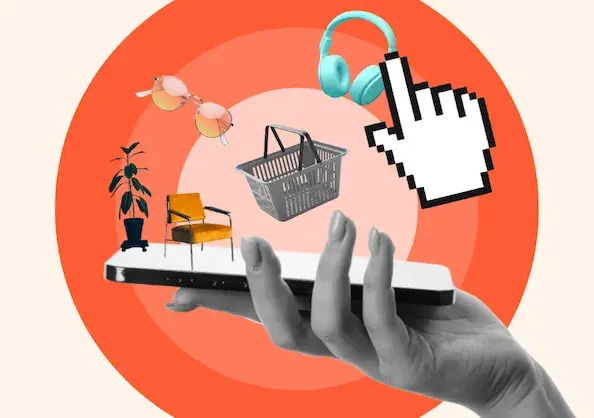Take a look at this customer review for the D2C mattress company, Casper. Despite this customer’s dissatisfaction with his mattress, he still gave the company five stars:

What is direct-to-consumer marketing?
Direct-to-consumer marketing is when a company markets its product or service directly to their consumers. This direct relationship can occur through methods like social media, YouTube, or podcasts, but not through TV, billboards, or magazine advertisements.
Creating innovative marketing campaigns is a necessity for D2C companies, many of which are up against some big-name competitors. Dollar Shave Club, for example, is up against Gillette razors, and Glossier’s makeup and skincare lines compete with stores like Sephora and Ulta.
The benefits of D2C marketing are clear: through this direct relationship, these companies are creating strong relationships with their consumers, understanding them better, and reaching a more specific, appropriate audience.
By controlling the start-to-finish buyer’s process, D2C companies reduce costs and have the advantage of focusing solely on consumers. D2C companies typically ship directly to consumers, partner with retail locations, or open pop-up shops to distribute their products.
Every D2C company does advertising a little differently. We’ve examined eight D2C companies that all share one thing in common: their one-of-a-kind approach to marketing and advertising has brought them lots of recognition, customers, and revenue.
Let’s examine these eight D2C companies and discuss what you can take away from their strategies. Whether you work for a D2C company or not, there are plenty of tangible marketing practices you can still try out for yourself.
1. Dollar Shave Club
No one can guarantee that a video will go viral. But it doesn’t hurt to have a strategy in place.
Dollar Shave Club, which sells — you guessed it — razors (among other bathroom essentials), launched their ecommerce company with a 1:33 minute video. Their video is wacky and memorable, with dance numbers, shaving babies, and a guy named Mike traipsing around a warehouse and making proclamations like, “Are the blades any good? No … our blades are f**ing great.”
The video was a huge success. In the first three months, it received 4.75 million views, and within the first two days of the company's launch, 12,000 people had already signed up for Dollar Shave Club razors.
The video doesn’t come across like an advertisement, it seems like a funny video your brother’s goofy friend made in his garage — which probably explains why so many people sent it to friends and shared it on social media. But Dollar Shave Club didn’t rely on organic reach alone to promote their launch video.
Before promoting their video, Dollar Shave Club reached out to tech publications to let them know when it was going live, provided these publications early access to the video, edited a shorter version to run on late-night TV, and spent $10,000 promoting it on social media, among other things.
They didn’t just reach out to any tech publications, either — they focused on media properties already reaching the male demographic they wanted to target, like Thrillist and Uncrate.
Takeaway: It may not be feasible to aim for a viral video, but it is possible to create great content and use your money and other resources to market it to the right demographic. Hopefully, your audience will do the hard work from there.
2. Glossier
When I think of Glossier, I think of one word: accessible. The makeup and skincare industry can be a complicated, convoluted world to navigate. Glossier has simplified the approach to buying beauty products, both through their marketing and product design.
Glossier’s advertising has no pretense. For example, rather than working with influencers, the brand gave free products to 500 “superfans” who had purchased the most product or engaged the most with the brand.
The evidence of Glossier’s cult following reverberates across social media. Customers and employees alike share videos and images sampling their products and teaching viewers how to properly use them. Moreover, the brand encourages customers of every age, ethnicity, and gender to showcase their Glossier, making the brand accessible on multiple levels.

Whether customers are ordering from Glossier’s ecommerce site or visiting one of its popular pop-up shops, the experience is unforgettable. Shoppers receive Glossier stickers and the memorable Glossier Pink Pouch (which Glossier even sold on its own).
Takeaway: Glossier has created a loyal following and accessible, fresh shopping experience in a convoluted industry. The brand creates a customer experience that can’t help but be shared on social media, serving as both user-generated content and customer advocacy.
3. Warby Parker
Warby Parker ’s D2C model eliminates the hassle of shopping for eyeglasses by sending you multiple pairs and letting you return the ones you don’t like. The convenience of choosing eyeglasses in your own home is Warby Parker’s biggest selling point.
Warby Parker knew their customers were already taking pictures and videos of their glasses to send to friends for advice, so they started asking customers to post their images on social media with the hashtag #warbyhometryon … as a reward for posting, Warby Parker pairs those customers with one of their online personal stylists. Today, almost 25,000 people have posted with the Warby Parker hashtag on Instagram.

The company also pays YouTube influencers to post videos of themselves trying different Warby Parker glasses on. The tactic is popular — there are currently tens of thousands of results on YouTube for “Warby Parker try on”. More importantly, encouraging people to share their home try-on experiences on social media also makes consumers more likely to buy. Warby Parker found that customers who shared content online were 50% more likely to make the purchase.
Takeaway: The #Warbyhometryon marketing campaign succeeded by encouraging customers to promote something they were already doing — taking photos and videos of themselves trying on eyeglasses — on social media, a channel through which Warby knew could reach their millennial audience. This effort also naturally created a highly-impactful user-generated content campaign that boosted awareness of the Warby Parker brand through its customers. By tapping into natural behaviors, Warby Parker was able to introduce its products to new customers as well as boost conversions.
4. Julep
Julep, a monthly customizable subscription beauty box, released a female empowerment video called Throw Anything at Me. The video features a woman putting on Julep makeup and then tackling issues related to women’s rights. On Julep’s website, the ad is described as a “celebration, a rallying cry, championing every woman’s innate power”.
The ad briefly features a few Julep products, but it mainly focuses on the woman in the ad and the things being “thrown” at her. It also introduces a bit of humor through the text message blurbs, a falling man holding wine and winking, and stunned onlookers.
Along with the ad, Julep made a similarly-named video game in which consumers could act like the female in the video and engage with the ad while having fun. Moreover, it brought viewers directly to the Julep website where they’d hopefully shop for products or subscribe to the beauty box.
Takeaway: There are plenty of subscription beauty boxes out there. To differentiate themselves, Julep didn’t advertise what it was — it advertised what it stood for. It helped build a sense of trust and camaraderie between customers and the brand prior to asking them to make a purchase.
5. Cards Against Humanity
Cards Against Humanity, a sarcastic and taboo card game founded in 2011, understands their audience very well. And, if you know your audience well, you can break the rules.
For instance, in 2013, Cards Against Humanity sold its product for $5 more on Black Friday, and sales actually went up. In 2015, they sold nothing for $5 … and received $71,000 from consumers. In 2016, they dug a hole in the ground and filled it back up — and raised $100,000 in the process.
I don’t know about you, but selling nothing sure seems like breaking the rules to me.

This strategy wouldn’t work for most companies, but it worked for Cards Against Humanity. The company knew their audience would pay attention, appreciate their sense of humor, and, pay for it.
Takeaway: While it may not be a good idea to sell nothing, remember it’s okay to employ some stunts if you trust your audience will get it. Who knows? You may profit in the process.
6. BarkBox
Everyone loves their dogs, but not everyone loves running constant errands to find and refill new food, treats, or toys. BarkBox noticed this market gap and created a subscription service that provide dog products, services, and experiences.
One thing that BarkBox does very well is cater to its target audience: urban dog owners who don’t have the time or means (i.e. transportation) to shop for or with their dogs. Unlike other pet subscription services like Chewy, BarkBox sends pre-packed, themed boxes to customers each month — customers don’t designate what they receive.
Since it’s conception, BarkBox has also expanded into other markets including an outdoor dog park community and an ecommerce site where customers can shop for products they received in other BarkBoxes.
Most importantly, BarkBox has built a community around their brand. BarkBox subscribers feel a sense of camaraderie with other customers, especially since most are receiving the same treats and toys in their boxes. This feeling alone has propelled over 300,000 customers to post about their #dogsofBark on Instagram.

BarkBox sticks to their narrative well: dogs first. They stay true to this even in their charity work — the brand donates 10% of its proceeds go to animal shelters.
Takeaway: BarkBox makes its customers feel as though they, and their dogs, are a part of a community through their subscription boxes and donations. Build camaraderie among your customers, and they’ll advocate for your brand.
7. Casper
Shopping for mattresses is an overwhelming experience. Besides feeling like goldilocks with the “soft, plush, semi-firm, and firm” options, you’re also forced to contemplate price, size, and whether you want memory foam, gel, or hybrid.
Mattress company Casper prevents this frustrating process by providing one, perfect-for-anyone mattress. Since Casper’s primary goal is to differentiate themselves from traditional mattress companies, they opt to use non-traditional marketing methods.
Casper focuses its marketing efforts in two places: New York City and Los Angeles. In New York, they've used MTA stations to post cheerful advertisements. They set up a satellite office in LA and have leveraged Hollywood connections and social media influencers. Kylie Jenner, for instance, posted a picture of herself on a Casper mattress, a photo that doubled Casper’s net sales.
Casper didn’t fight to stand out in the traditional mattress industry. Instead, they used urban spaces to reach their target millennial audience and worked with social media influencers to display their brand as trendy and unique.
The brand has also been running TV ads since it opened its doors, reporting that, “TV is the mass media that provides a very large reach in a limited amount of time...when bought efficiently, [it] allows us to maximize repetition and therefore increase brand recognition.”
Takeaway: While it’s wise to learn from businesses who’ve come before you, don’t hesitate to try some non-traditional or out-of-the-box methods to start out and garner attention. Also, invest in methods that build awareness around your brand, not only sell products. This is how you continually bring in new customers — an important distinction for Casper as even the most loyal customers don’t need new mattresses every month or year.
8. Blue Apron
Blue Apron sources, ships, and simplifies the process of making healthy, local food for customers. The brand includes ready-to-use recipes that correspond with each subscription box’s ingredients.
The company faces a lot of competition nowadays from other subscription meal services, including Amazon, HelloFresh, Green Chef, and Plated. As a result of this competition, Blue Apron’s biggest challenge has been explaining how their product stands out from the rest.
In 2015, Blue Apron reached out to popular food bloggers like Naomi of Love Taza and Anne of Fannetastic Food, as well as social media influencers, and asked these industry leaders to explain in-depth what Blue Apron was. This is generally an effective strategy, as food bloggers and social media influencers have already gained the trust of their audience.

Blue Apron then took it a step further, sponsoring their content on podcasts like Gimlet Media and The No Sleep Podcast. The company recognized podcasts as a worthwhile investment. Almost 50 million people ages 13 and up listen to podcasts, but more than one-third of the top 100 iTunes podcasts have no ads at all. With plenty of supply and little demand, Blue Apron’s sponsored content stood out from the rest.
Employing social media influencers and bloggers to promote their brand, and sponsoring ads on podcasts, paid off: In 2015, Blue Apron sales increased by 500%.
Takeaway: Blue Apron separated itself from the competition by using industry influencers to reach already-engaged audiences and promoting its content on appropriate (and less-crowded) platforms like podcasts.
These eight direct to consumer brands are impacting ecommerce and customer expectations in major ways. Implement some of the strategies and best practices from this article for your own business.
Ecommerce




.png)

![50 Ecommerce Statistics To Know in 2024 [New Data]](https://53.fs1.hubspotusercontent-na1.net/hubfs/53/ecommerce-statistics.png)





![Starting an Ecommerce Biz? Here are 12 Steps to Get Started [+ Best Practices]](https://53.fs1.hubspotusercontent-na1.net/hubfs/53/ecommerce_1.webp)